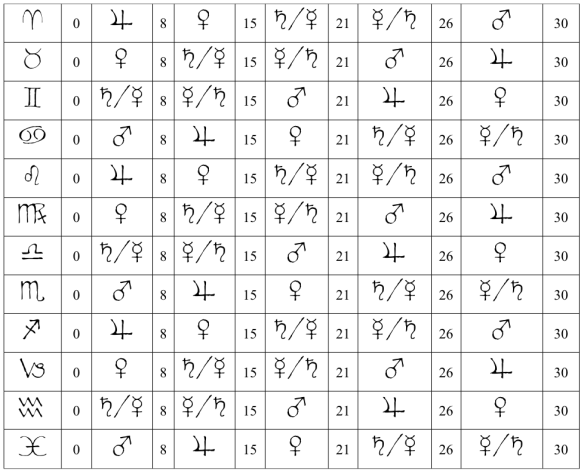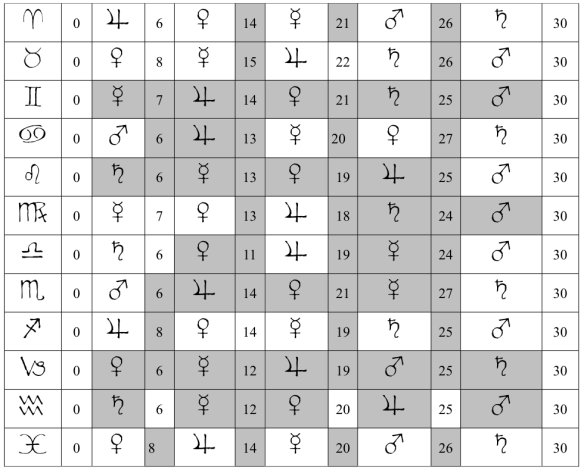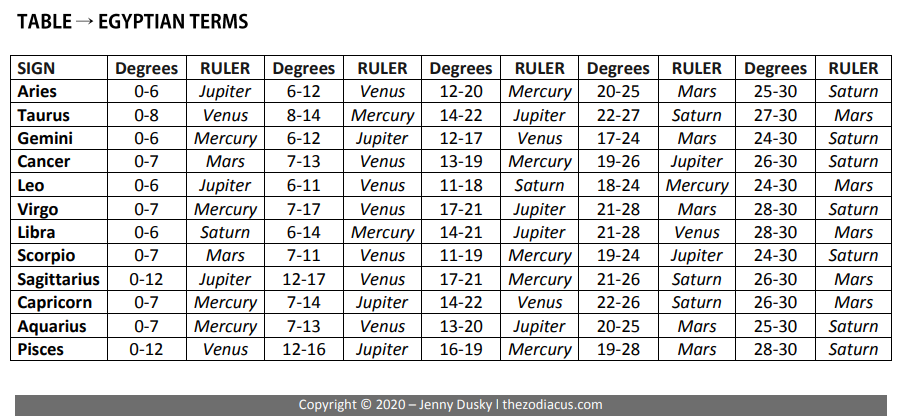Of the Disposition of Terms: The 3 Systems [According to Egyptian Ptolemy]
last updated:28/Nov/2021
Considerations
This is a very, very interesting topic in astrology, not much recognized and discussed its “power” by modern society of astrologers, nevertheless the systems are there, ready to be used and understood, for prediction or simple character reading or even for colors etc. The Terms and the 3 systems are a long topic to put it together in detail, thus it needs time and I won’t do it for now, but be happy that I still discuss it in 6 pages of Office Word here.
Also known as the Bounds, the Terms of the Zodiac are the Signs divided unequally [60 divisons], contrary to the Decanate divisions [36] whereas all posses 10° degrees each decanate/face. For such reasons, astrologers like Ptolemy are unsure to what system should be used, the Egyptian or the Chaldean, or, is there another one older them those? According to the author, yes, but is it better? Let’s find out now.
Of the Disposition of Terms
What is your Asc Term? Which house is the Term Planet located at? Is it making aspect to the Asc itself?
Or, what is your Jupiter’s Bound? Is it Jupiter himself? Planets in terms with themselves are reinforced, they can see their image in the mirror, identifying oneself – counscious and abound.
When a Planet Exalted is bounded with itself, it is like double advantages – ex. suppose Saturn transits Libra’s first 6° degrees (any of the systems), the planet gets even more dignity than the Exaltation already provides. The contrary, happens to Planets at their Falls and positioned badly and in terms with themselves. It’s like there is no other way but to cope with it somehow forcedly, for better or worse.
Also let a Malefic like Saturn be in terms with a benefic, then, shall Saturn be luckier than usual – as Porphyry would point out. Even, let a Benefic like Venus be in terms with Jupiter, shall the planet be more of everything that Venus already represents.
However, there are disputes to whether or not to use the ‘Chaldean/Chaldaic’ or ‘Egyptian’, including Ptolemy himself, which later identified another table which is said to be older than the Egyptian Terms, known today as the ‘Ptolemy’s Table’ even when his is not. These tables differ in many degrees and rulers/lords of the Terms as well as the rationale behind their construction. Read it:
“With regard to the terms two systems are most in circulation; the first is the Egyptian, which is chiefly based on the government of the houses, and the second the Chaldean, resting upon the government of the triplicities.”
Terms according to the Egyptians
Ptolemy from this part of the chapter will tell how us he doesn’t fully trust both the Egyptian & Chaldean Systems because he thought they lack clarity of line thought but still giving preference for the Egyptian, for example, they say the Egyptians made that order based on the rulers/lords of the houses, but Ptolemy observes that the first degrees of Libra has Saturn as ruler of the Term/Bound and not Venus.
He comments from this point of view and goes from there, also questioning some of the assigned terms based on the exaltation and triplicities rulers not making the right correlation.
“Now the Egyptian system of the commonly accepted terms does not at all preserve the consistency either of order or of individual quantity. For in the first place, in the matter of order, they have sometimes assigned the first place to the lords of the houses and again to those of the triplicities, and sometimes also to the lords of the exaltations. For example, if it is true that they have followed the houses, why have they assigned precedence to Saturn, say, in Libra, and not to Venus, and why to Jupiter in Aries and not to Mars? And if they follow the triplicities, why have they given Mercury, and not Venus, first place in Capricorn? Or if it be exaltations, why give Mars, and not Jupiter, precedence in Cancer; and if they have regard for the planets that have the greatest number of these qualifications, why have they given first place in Aquarius to Mercury, who has only his triplicity there, and not to Saturn, for it is both the house and the triplicity of Saturn? Or why have they given Mercury first place in Capricorn at all, since he has no relation of government to the sign? One would find the same kind of thing in the rest of the system.”
“Secondly, the number of the terms manifestly has no consistency; for the number derived for each planet from the addition of its terms in all the signs, in accordance with which they say the planets assign years of life, furnishes no suitable or acceptable argument. But even if we rely upon the number derived from this summation, in accordance with the downright claim of the Egyptians, the sum would be found the same, even though the amounts, sign by sign, be frequently changed in various ways. And as for the specious and sophistic assertion about them that same attempt to make, namely that the times assigned to each single planet by the schedule of ascensions in all the climes add up to this same sum, it is false. For, in the first place, they follow the common method, based upon evenly progressing increases in the ascensions, which is not even close to the truth. By this scheme they would have each of the signs Virgo and Libra, on the parallel which passes through lower Egypt, ascend in 38 1/3 times, and Leo and Scorpio each in 35, although it is shown by the tables that these latter ascend in more than 35 times and Virgo and Libra in less. Furthermore, those who have endeavored to establish this theory even so do not seem to follow the usually accepted number of terms, and are compelled to make many false statements, and they have even made use of fractional parts of fractions in the effort to save their hypothesis, which, as we said, is itself not a true one.”
“However, the terms most generally accepted on the authority of ancient tradition are given in the following fashion:”
According to the Chaldeans
“The Chaldaean method involves a sequence [0°-08°-15°-21°-26°-30°], simple, to be sure, and more plausible, though not so self-sufficient with respect to the government of the triangles and the disposition of quantity, so that, nevertheless, one could easily understand them even without a diagram. For in the first triplicity, Aries, Leo, and Sagittarius, which has with them the same division by signs as with the Egyptians, the lord of the triplicity, Jupiter, is the first to receive terms, then the lord of the next triangle, Venus, next the lord of the triangle of Gemini, Saturn, and Mercury, and finally the lord of the remaining triplicity, Mars. In the second triplicity, Taurus, Virgo, and Capricorn, which again has the same division by signs, Venus is first, then Saturn, and again Mercury, after these Mars, and finally Jupiter. This arrangement in general is observed also in the remaining two triplicities. Of the two lords of the same triplicity, however, Saturn and Mercury, by day Saturn takes the first place in the order of ownership, by night Mercury. The number assigned to each is also a simple matter. For in order that the number of terms of each planet may be less by One degree than the preceding, to correspond with the descending order in which first place is assigned, they always assign 8° to the first, 7° to the second, 6° to the third, 5° to the fourth, and 4° to the last; thus the 30° of a sign is made up. The sum of the number of degrees thus assigned to Saturn is 78 by day and 66 by night, to Jupiter 72, to Mars 69, to Venus 75, to Mercury 66 by day and 78 by night; the total is 360 degrees.”

There numbers of degrees of the sequence is from the number 8; this is Venus’s Lesser Years – once the division begins with the second sign of the Zodiac Taurus, and it is ruled by Venus; the first being that of 0° degrees Aries. From Venus lessen years, the sequence rebates – The second term to number 7, the third term ‘contains’ 6° degrees, the fourth term 5° degrees and the last 4° degrees until the 30° degrees of any of the Zodiac Signs.
The first degrees are assigned to the planets which are rulers or lords of the triplicities, for example: any of the Fire signs will begin bounded with Jupiter in their first fixed sequence [0°-8°]. Of the Earth signs, in terms with Venus and so forth with the rest of the Zodiac signs.
Now, the second term of each sign is then re-arranged according to the lord of the Triplicity of the next sign. For example, Taurus is part of the Earth Triplicity, thus the Lord of the triangle is Venus, and as a sequence, Venus becomes the second planet bounded in the sign of Aries. The third Term would be the Lord of the Triplicity of the next Zodiac Sign and so forth.
The thing is that the Chaldeans put Mercury paired with Saturn whenever either appear, changing also the sequence, because then Saturn or Mercury will always rule the next term with no regards to the next sign as the logical sequence proposed at first. Nevertheless, I think Ptolemy went to extremes in pointing it as not self-sufficient. But I guess this is where practice will tell each astrologer their preferred system of Terms.
Terms according to Ptolemy
“Now of these terms those which are constituted by the Egyptian method are, as we said, more worthy of credence, both because in the form in which they have been collected by the Egyptian writers they have for their utility been deemed worthy of record, and because for the most part the degrees of these terms are consistent with the nativities which have been recorded by them as examples. As these very writers, however, nowhere explain their arrangement or their number, their failure to agree in an account of the system might well become an object of suspicion and a subject for criticism.”
I think from this point the author really wanted people to begin using this enigmatic third system. I am actually curious now because Ptolemy kind of seems redundant to explain. He won’t say the source of such damaged manuscript that contained the explanation of the order and degrees, and at the end of it he said there was this table of the Terms he would use if practitioner of astrology.
“Recently, however, we have come upon an ancient manuscript, much damaged, which contains a natural and consistent explanation of their order and number, and at the same time the degrees reported in the aforesaid nativities and the numbers given in the summations were found to agree with the tabulation of the ancients. The hook was very lengthy in expression and excessive in demonstration, and its damaged state made it hard to read, so that I could barely gain an idea of its general purport; that too, in spite of the help offered by the tabulations of the terms, better preserved because they were placed at the end of the book. At any rate the general scheme of assignment of the terms is as follows.”
“For their arrangement within each sign, the exaltations, triplicates, and houses are taken into consideration. For, generally speaking, the star that has two rulerships of this sort in the same sign is placed first, even though it may be maleficent. But wherever this condition does not exist, the maleficent planets are always put last, and the lords of the exaltation first, the lords of the triplicity next, and then those of the house, following the order of the signs. And again in order, those that have two lordships each are preferred to the one which has but one in the same sign. Since terms are not allotted to the luminaries, however, Cancer and Leo, the houses of the sun and moon, are assigned to the maleficent planets because they were deprived of their share in the order, Cancer to Mars and Leo to Saturn; in these the order appropriate to them is preserved. As for the number of the terms, when no star is found with two prerogatives, either in the sign itself or in those which follow it within the quadrant, there are assigned to each of the beneficent planets, that is, to Jupiter and Venus, 7° ; to the maleficent, Saturn and Mars, 5° each; and to Mercury, which is common, 6°; so that the total is 30°. But since some always have two prerogatives for Venus alone becomes the ruler of the triplicity of Taurus, since the moon does not participate in the terms there is given to each one of those in such condition, whether it be in the same sign or in the following signs within the quadrant, one extra degree; these were marked with dots. But the degrees added for double prerogatives are taken away from the others, which have but one, and, generally speaking, from Saturn and Jupiter because of their slower motion. These terms is as follows :”

Conclusion
Ptolemy agreed that the preferred table/system was the Egyptian instead of the Chaldean/Chaldaic, but that doesn’t mean astrologers weren’t still using the other system. The antagonist also introduced, or, re-introduced a table apparently older but “new” to his times. To be honest, after doing this discussion on Terms, I am actually curious of the Chaldean system. And, for now at least, I have no interest in using this third unknown system of Ptolemy.
The same as with the ‘Decans’ in astrology, the Terms or bounds also add their “voice” to the planets, contributing or diminishing planetary significations as result.
Observe that the luminaries are never assigned to any table of the Terms. The Sun and Moon have already their halves, the Diurnal and Nocturnal Signs of the Zodiac.
I must/will do some research utilizying the Chaldean and let’s see it.
Until now, I’ve always used the Egyptian one. What about you dear ones?
—
References
Chaldean & Ptolemy’s Terms Tables from: https://altairastrology.wordpress.com/2009/03/01/more-on-the-terms-or-bounds/
Tetrabiblos Ptolemy’s four books of the influence of the stars [or the Quadripartite Mathematical Treatise] translated from the Greek paraphrase of Proclus by j. m. Ashmand – [London, Davis and Dickson; 1822]
Ptolemy. Tetrabiblos. Translated by F. E. Robbins. Loeb Classical Library 435. Cambridge, MA: Harvard University Press, 1940.
Porphyry The Philosopher – Introduction To The Tetrabiblos & Serapio Of Alexandria; Astrological Definitions (Translated from the Greek by ] James Herschel Holden, M.A.)
Go back to Ptolemy’s Way and read the references

